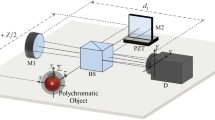Abstract
"Synthetic schlieren", which has been used to measure the amplitude of two-dimensional internal wave beams generated from an oscillating cylinder, is adapted to analyze axisymmetric internal waves generated by an oscillating sphere. This nonintrusive technique uses elementary inverse tomographic methods to measure the amplitude of the conical-structured wave beams everywhere in space and time. We compare the results with in situ probe measurements, and we examine the structure of the wave beams generated by a sphere oscillating at different amplitudes.






Similar content being viewed by others
References
Appleby JC, Crighton DG (1987) Internal gravity waves generated by oscillations of a sphere. J Fluid Mech 183:439–450
Ben-Israel A, Greville TNE (1974) Generalized inverses: theory and applications. Wiley, New York
Dalziel SB (1992) Decay of rotating turbulence: some particle tracking experiments. Appl Sci Res 49:217–244
Dalziel SB, Hughes GO, Sutherland BR (2000) Whole field density measurements. Exp Fluids 28:322–325
Greenberg PS, Klimek RB, Buchele DR (1995) Quantitative rainbow schlieren deflectometry. Appl Optics 34:3810–3822
Irvin BR, Ross J (1991) Observations of pattern evolution in thermal convection with high-resolution quantitative schlieren imaging. Phys Fluids A 3:1699–1710
Lighthill MJ (1978) Waves in fluids. Cambridge University Press, Cambridge
Menke W (1983) Geophysical data analysis. Academic Press, New York
Mowbray DE (1967) The use of schlieren and shadowgraph techniques in the study of flow patterns in density stratified liquids. J Fluid Mech 27:595–608
Mowbray DE, Rarity BSH (1967) A theoretical and experimental investigation of the phase configuration of internal waves of small amplitude in a density stratified liquid. J Fluid Mech 28:1–16
Oster G (1965) Density gradients. Sci Am 213:70–76
Press WH, Flannery BP, Teukolsky SA, Vetterling WT (1993) Numerical recipes: the art of scientific computing, 2nd edn. Cambridge University Press, New York
Stevenson TN (1969) Axisymmetric internal waves generated by a travelling oscillating body. J Fluid Mech 35:219–224
Sutherland BR, Dalziel SB, Hughes GO, Linden PF (1999) Visualisation and measurement of internal waves by "synthetic schlieren". Part 1: Vertically oscillating cylinder. J Fluid Mech 390:93–126
Sutherland BR, Hughes GO, Dalziel SB, Linden PF (2000) Internal waves revisited. Dyn Atmos Ocean 31:209–232
Sutherland BR, Linden PF (2002) Internal wave excitation by a vertically oscillating elliptical cylinder. Phys Fluids 14:721–731
Voisin B (1991) Internal wave generation in uniformly stratified fluids. 1. Green's function and point sources. J Fluid Mech 231:439–480
Weast RC (ed) (1981) Handbook of chemistry and physics, 62nd edn. CRC, Boca Raton
Acknowledgments
We are grateful to S. Dalziel and G. Hughes for their insights during the initial stages of this work. This work was supported by funding from the Natural Sciences and Engineering Research Council (NSERC) of Canada, Grant No. 203065-00, and NSERC's USRA program.
Author information
Authors and Affiliations
Corresponding author
Scaling analysis
Scaling analysis
Here we give a detailed explanation of how the approximate solution to Eq. (6), given by Eq. (7), has been obtained through scaling and perturbation analysis. Equation (6) is simplified by dropping terms that are revealed to be small by a scaling analysis. In the x-direction, we expect variations on scales L x , which is on the order of the sphere radius, on the order 1–10 cm in our experiments. In the z-direction, the length scale L z is set to the vertical distance traveled by a ray as it progresses from the front to the back of the tank. In typical experiments, L z ≃1 cm, N 0 2~1 s−2 and γ~10−4 s2/cm. We transform to nondimensional variables (denoted by tildes) with the substitutions \( \left( {x,z} \right) = \left( {L_x \tilde x,L_z \tilde z} \right),\;\alpha _0 = n_0 \tilde n \) and \( \alpha _1 = - \gamma n_0 N_0 ^2 \widetilde{N^2 } \). Thus Eq. (6) becomes
Substituting typical characteristic scales and supposing first that L x ~1 cm, we obtain
The leading order equation is
with solution
where z i refers to the initial height of the ray and ϕ i refers to its angle as it enters the stratified medium.
At next order, ε=10−4, perturbation theory with \( z \simeq \tilde z^{\left( 0 \right)} + \varepsilon \tilde z^{\left( 1 \right)} \) gives the equation
Using Eq. (19), the solution is found:
Repeating this procedure but supposing L x ≃10 cm gives the equation
The leading order equation is again given by Eq. (19). At next order, ε=10−2, the corresponding equation for \( \tilde z^{(1)} \) is identical to Eq. (21) after using Eq. (19).
Therefore, for waves with horizontal scales ranging between 1 and 10 cm, we find
Finally, we note that variations in the refractive index occur on the order Δn/n~10−5, whereas typical changes in the buoyancy frequency due to waves occur on the order ΔN 2/N 0 2~10−1 to 10−2. Thus, we can treat n(x) as approximately constant in the denominator in Eq. (24) to give Eq. (7).
Rights and permissions
About this article
Cite this article
Onu, K., Flynn, M.R. & Sutherland, B.R. Schlieren measurement of axisymmetric internal wave amplitudes. Exp Fluids 35, 24–31 (2003). https://doi.org/10.1007/s00348-003-0609-x
Received:
Accepted:
Published:
Issue Date:
DOI: https://doi.org/10.1007/s00348-003-0609-x




